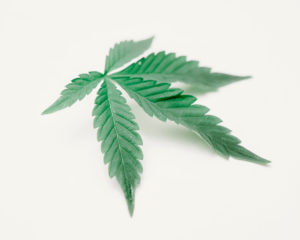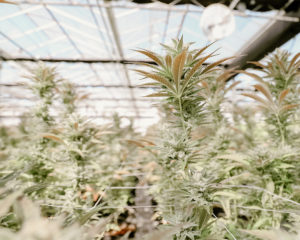Many innovative materials have emerged to combat our overreliance on fossil fuel-derived materials like plastic and their impact on the environment. One material that has been present in the background for around 50,000 years is hemp. Blighted for a long time by an association with its close cousin, marajuana, hemp has never achieved the proliferation such a versatile and sustainable plant ought to. But in the wake of changing legislation in 2018 on farming hemp in the US, now looks like hemp’s time to shine.
Today more than 50% of executives in fashion think that sustainability ought to be a guiding principle for their brands and hemp fabric is one of the materials that appears to offer a sustainable alternative to cotton. But beyond its most recognisable use in textiles, hemp is also being turned into everything from food products, to cosmetics, and a lightweight bio-concrete.
But what exactly is this much-maligned plant, can it be considered a zero-waste material, and what can we expect to see from it in the near future?
What is Hemp?
Hemp is part of the Cannabaceae plant family, which as we all know by now also includes marajuana. Yet hemp is a different variety of the cannabis plant, one that has been bred for use as a physical material, not for its psychoactive compounds (cannabinoids). As a result hemp contains far less THC (tetrahydrocannabinol) than marajuana grown for medical or recreational use. In fact by law industrial hemp must not contain more than 0.3% THC , the main psychoactive compound in marajuana. Typically medicinal marajuana contains around 30-40 times this amount of THC. In short, industrial hemp will not make you ‘high’.
How is Hemp Farmed?
Hemp is considered a sustainable, natural fiber, but how exactly does this plant go from the field to an eco-friendly t-shirt? Well, the fibers from inside the hemp stalk are harvested and made into thin, durable threads which can in turn be woven into fabric, or rope among other things. The mechanical separation of the fibers is known as decortication and one reason that hemp is considered sustainable is because it is processed mechanically, rather than with the use of chemicals which may harm the environment, as is sometimes be the case with another sustainable material, bamboo.
Is Hemp a Zero-Waste Product?
One of the reasons hemp is considered a zero-waste material is because processing it avoids releasing harmful chemicals into the environment (its effluent can be recycled). But there are many more reasons why hemp can be thought of as a zero-waste material. The most literal reason is that we don’t have to throw away any of the hemp plant when harvesting; the entirety of the plant can be used.
When we think about how hemp is produced on the land we can see how sustainable a crop it really is. The hemp plant naturally undertakes a process known as phytoremediation, which essentially means purging the soil of toxins. This process allows the plant to regenerate the surrounding earth for future farming and encourages biodiversity. Crucially, farming hemp doesn’t require a lot of water compared to crops such as cotton, and like bamboo it grows very quickly and gives a high yield. The hemp plant also absorbs CO2 from the air around it, negating dangerous greenhouse gasses. All these boons combine to earn hemp the label of a truly carbon-negative, zero-waste crop.
Is Hemp Biodegradable?
Does all this mean that hemp is biodegradable? Yes, as an organic material hemp is biodegradable, it can be composted and it doesn’t not emit greenhouse gasses as it decomposes. However, whether or not that hemp product you bought is itself biodegradable depends on which other materials make up the final product. Hemp is often used in combination with other materials, particularly in clothing alongside cotton.
Is Hemp Legal?
Hemp shares the same genus as marajuana in the cannabis plant, but the levels of THC are much lower. Despite this fundamental difference, hemp farming was only fully legalized in the US in 2018. This has been the major factor working against its proliferation as a useful crop and an alternative to less sustainable materials. Although hemp had hitherto been farmed in certain states and with specifically acquired licenses, the new federal law means interstate trade and financing from banks can increase and thus the industry as a whole is set to boom. Until recently China accounted for 50% of the world’s hemp production but this is set to change as US farmers gear up. Farmers are going to be able to access government subsidies and some are tipping the crop for enormous growth in the coming years.
Although hemp farming is now entirely legal, there are still some barriers in the paths of US hemp manufactures. Cannabis derived products (e.g. hemp) cannot legally be advertised on social media platforms like Instagram and Meta. A hangover from the negative connotations of cannabis.
Is Hemp More Sustainable Than Cotton?
Hemp is unequivocally a more sustainable alternative to cotton when it comes to the clothing industry. A quarter of the farmland in the United States is devoted to cotton and the industry is still a multi-billion dollar asset for the US economy, but there’s no getting around the fact that cotton is not good for the environment.
Cotton is normally grown as a monoculture which means nothing else can be farmed alongside it. The result of this is degradation of soil quality over time until the land is rendered unfarmable. And while hemp doesn’t require pesticides or herbicides to resist pests, most cotton has been genetically modified to such an extent that it leaves an enzyme in the soil that it further damages the biodiversity of the land. Whastmore, cotton uses 16% of the world’s insecticides while hemp can largely take care of itself in that regard.
In terms of input resources, hemp uses less than a third of the water that cotton needs and produces more than double the fiber. Whatsmore, when compared to cotton, hemp has distinct advantages for the fight against climate change – the plants actively capture CO2 from the atmosphere. All in all, hemp comes out as a far more sustainable material than cotton.
What Are The Benefits of Hemp?
Hemp may be easily classed as a sustainable material but what are the wider advantages of hemp as a crop?
- Hemp grows fast
Hemp grows very quickly and can be harvested after only three to four months’ growth, by which time it’ll have shot up to around four meters. This is compared to roughly 6 months for cotton.
- Hemp is versatile
Although famed for being woven into sustainable clothing, hemp has a number of uses in less recognizable forms. For example in building materials such as Hempcrete, as a nutritional food supplement, a more durable paper alternative to wood-based paper.
- Hemp kills weeds
As well as sequestering CO2 from the air more effectively than forests, hemp also helps to break down toxic material in the soil around it, contributing to biodiversity in the surrounding area.
- Hemp is strong and durable
Hemp is extremely strong and can be combined with bioplastics to make durable metal replacements. Even cars may soon be made out of hemp.
- Hemp is antimicrobial and hypoallergenic
A strong fabric for clothing, hemp is not only more durable than cotton and bamboo but its antimicrobial properties mean it could be worn for longer without washing. And of course, less water is always good. Speaking of water, hemp is also naturally more water resistant than cotton and has a higher UV protection factor than cotton clothing.
What are the Disadvantages of Hemp?
Hemp has suffered from negative connotations which has in turn made it less widely available and thus more expensive to acquire. The nature of so-called fast fashion has not rewarded durability of material – which is one of hemp’s primary advantages over cotton, at least from an end user perspective. The association with marijuana has also led brands to keep quiet about using hemp despite its great environmental credentials.
Hemp wrinkles easily and is not able to hold brighter colors like cotton unless combined with other materials. It is also rougher than cotton and can require blending with other materials, which in turn reduces its sustainability rating. If those materials are synthetic then it also affects the biodegradability of the product. However, brands like Levis have pledged to make hemp clothing as soft as cotton within five years, and without relying on chemical processes.
Although mechanized, the farming of hemp can be very labor intensive and thus require higher labor wages and dissuade farmers from introducing it. Lastly, although hemp doesn’t rely on herbicides and pesticides, it does require more fertilizer than other alternative fibers, increasing its environmental impact somewhat.
As we’ve seen, hemp is more sustainable than cotton and is tipped to become a massive commodity over the next twenty years, but it requires farming on a wider industrial scale to become economically viable.
How Else Can Hemp Be Used?
Although fashion has taken up a large chunk of the discourse around hemp, because of the scale of the cotton industry it looks set to eat into, there are numerous other emergent and established uses for hemp.
- Building Materials
Hemp can be used for insulation or as Hempcrete; a concrete made of hemp that is reportedly seven times lighter than regular concrete and less brittle. Though not strong enough for foundations, hemp-concrete can be used in walls as a lightweight, insulating alternative to concrete.
- Hemp Biodiesel
Oil extracted from hemp seeds can be used directly in diesel engines, however production is currently extremely low because of the cheaper alternatives available from sources like organic food waste.
- CBD Oil Made From Hemp
CBD oil can be produced from hemp plants although not from the seeds but the flowers. CBD oil has emerged as a still-debated medicinal treatment for many things from anxiety to chronic pain.
- Hemp Plastics
Bioplastics, made from the hurd and the cellulose of the hemp plant, have emerged as a durable alternative to plastic for many commodities, but none more so than plastic packaging. Hemp bioplastics can biodegrade in as little as six months but offer an extremely durable alternative to plastic which can take advantage of existing manufacturing equipment and processes such as injection molding. It is thought that 40% of the plastics industry will be bioplastics in 2030 – hemp could be at the heart of that.
- Hemp Paper
Hemp paper does not require chlorine bleaching like wood-based paper, and can be produced in a closed-loop system with the effluent being recycled and having no impact on the environment. It also needs far less water and can be recycled up to four times more than wood-based paper.
Visit the blog for more tips and guides on going zero waste, or check out the shop to see what sorts of products are making clever use of zero waste raw materials.




